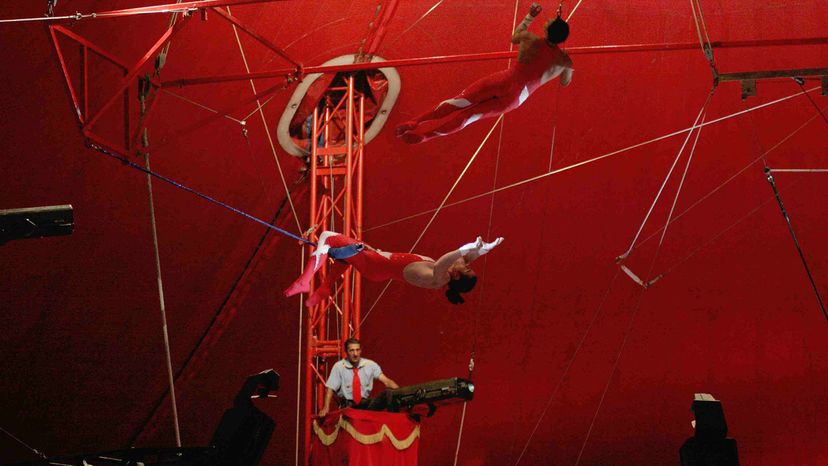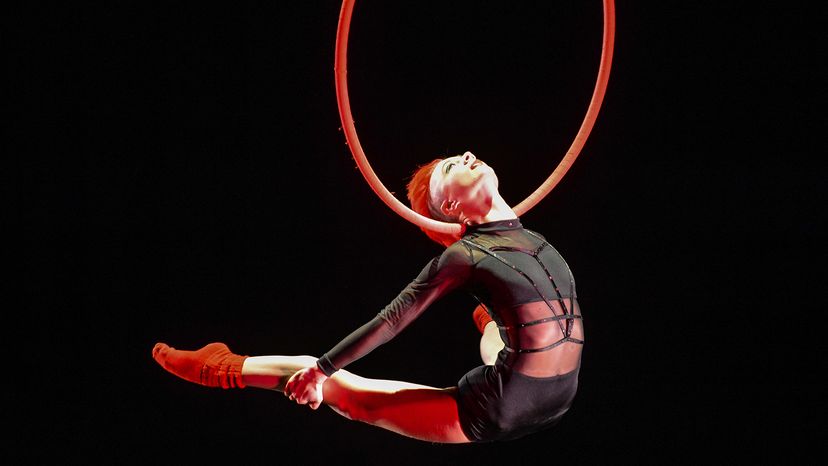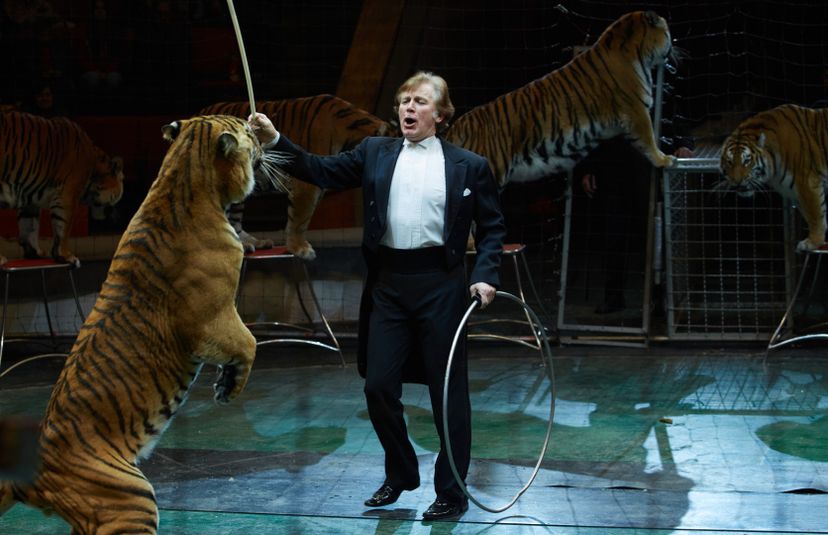
If all the safety strategies in the circus were totally transparent to the audience, we would be incredibly bored in the big top. Because when we say the audience can't "see" the safety measures, we don't mean they're secretly wearing tiger-repellent vests or gravity-defying underwear that allow acrobats to fly with ease between trapeze bars. Instead, there's a pretty rigorous behind-the-scenes series of checks and balances that make performances run smoothly.
Of course, as with all things circus, that doesn't mean you should expect the mundane. We'll fill you in on what keeps the circus humming, and some of it really might surprise you. Let's just say that for certain performers, a healthy scalp could literally save your life.
Advertisement
But let's start with a really basic part of circus safety that audience members may not ever notice: the all-important rigging systems. Step right up to find out how performers fly through the air with such ease.
10: Rigging
A lot of hidden mechanisms for safety under the big top are tied into aerial acts. And for a good reason, of course: Hanging dozens of feet in the air — let alone performing acrobatic stunts or flying from one spot to another while doing it — can't exactly be a spontaneous act. Experts control the rigging that keeps aerialists safe, but the audience doesn't see them.
When we say rigging, we're referring to the wires or lines that control the performers' movement in the air. While we might be able to name a standard for rigging in, say, window washing or construction, it's not really possible to detail how rigging works in the circus in a brief description. That's because acts in the circus strive to be unique, and the rigging systems that are created for the performers must be specific to the actions they're executing. But let's take a closer look at one rigging element many circus acts use.
9: Joysticks and Kill Switches
In order to talk about some rigging and safety strategies the audience doesn't see, we're going to take a closer look at a terrible Cirque du Soleil accident that caused the death of a performer in 2013. To understand why the accident happened, we'll examine a few safety strategies that unfortunately went awry. Sarah Guillot-Guyard was an aerialist with the "Ka" show in Las Vegas when her wire snapped and she fell 94 feet (29 meters) [source: Berzon and Maremont].
In order to rise and drop at the levels needed, aerialists carry joysticks to control their speed. No, it's not some stagehand grunting heavily as he pulls wires hand over hand: Performers use a mechanized tool to lift and lower themselves. Since performers can go as fast as 11 feet (3.4 meters) per second, you might understand why they have technicians with "kill switches," which are designed to turn off the rigging at signs of trouble [source: Berzon and Maremont]. Those emergency switches are one more safety strategy that the audience is blissfully unaware of. In Guillot-Guyard's case, she rose much more quickly than expected, and the kill switch was never activated.
8: Mechanics
Circuses, of course, aren't all aerials and flying trapeze acts. While we might think of equestrian performances as safer than airborne acts, it's hard to believe that vaulting off a 1,000-pound (454-kilogram) horse galloping at full speed is for more reserved performers. And yeah, sure: Perfecting every trick really might involve simply getting back on the horse (pun intended), but there's certain safety equipment required in some circuses for equestrian practice.
In the circus, a mechanic isn't the guy who charges you twice for something you didn't need in the first place. Instead, it's a safety belt performers wear that can lift them away from a horse should something go awry. The ropes can be slack so performers can easily practice their tricks, but a crew member keeps an eye out to quickly tighten them if a fall or accident occurs. Sure, you might not see it in the ring as an audience member, but it's an extremely important safety strategy during rehearsal as folks (or animals) learn their routines.

7: Learning to Fall
Many of us non-circus folk would assume that the best way to stay safe doing a trick is to never, ever make a mistake while performing it — even during practice. And that is, of course, true: It's a pretty terrible idea to get lazy while performing and simply count on a backup plan. In fact, some aerialists don't use nets if they're working closer to the ground or using equipment that may tangle, and it keeps them on alert. But that doesn't mean, of course, that they're not preparing for danger.
A significant part of practice that the audience doesn't see? Learning to make a mistake correctly. Because even something like taking a tumble off the trapeze can't be done without serious prep. One must drill the safest and most effective way to fall into a net, for instance. It might sound like an easy task ("Hey, I can let gravity do its job without practicing once!"), but it becomes a little more complicated when you realize the net itself can be dangerous. Because it's strung so taut, you can hit the net and bounce out or even suffer a broken bone if you don't prepare your body correctly for impact.
6: Hair Strength
Oh, what — you never realized that a good conditioner was so wildly important to circus safety? Silly you. Lots of circus performers swear by a healthy scalp to stay secure and safe in the ring. If you're starting to wonder whether this list has lost its beautiful luster, then you're forgetting (or perhaps never knew) the world of circus hair hanging.
Hair hanging first caught on as a performance act in China, but it's become a contemporary hit for audiences. Essentially, hair hanging is an acrobatic or contortionist act where the performers are — you guessed it — suspended by their generally substantial locks. And while it might look like that's the gist of it to a cringing audience member, there's actually quite a bit of safety prep that goes into making the hair strong and ready for a good dangle. Some performers condition their hair several times a day. But the coolest thing might be the braid that performers use. There are specific types of braids that distribute weight well on the ring so the act is less painful and the hair is stronger. Want to know any of them? No can do: They're well-kept secrets that an audience member can never know.
5: Engineers
It's not good that it took a tragedy to get the job done, but a recent development in circus safety could be a significant step toward increasing performer protection. In a terrifying accident in 2014, eight hair-hanging aerialists fell to the ground when a clip securing them failed [source: Buteau]. While none of the artists died, there were severe injuries.
In response, Ringling Bros. and Barnum & Bailey Circus agreed to make a few changes to the safety protocol used in their aerial acts. One of the biggest changes is that a registered, professional engineer is now required to review the acts and equipment [source: Shalvey]. A checklist is also required for hardware and equipment assessments, and employees have a "safety day" to ensure communication about practices or issues.
The measure doesn't just affect one act, either — it's for all aerial acts and hopefully will help guarantee a more concrete safety strategy.
4: Regulations
Although reading about circus disasters can be pretty depressing, a lot of the circus safety strategies you (don't) see today have been in response to accidents that occurred under the big top. The 1944 Hartford, Connecticut circus fire caused the loss of 167 lives and left hundreds injured when the tent covering the ring caught fire [source: The Hartford Circus Fire]. There weren't enough proper exits, and the ensuing panic caused a stampede and chaos.
After the Hartford tragedy, it was obvious that regulations had to be improved for traveling entertainment that used temporary structures. The Hartford fire prompted national safety regulations for circus, carnival and fair entertainment through the American Standards Association. Now tents have to be fireproof, trained fire personnel have to be on-site, and exits are regulated. So while you may be blissfully unaware while watching a clown goofing off, know that some serious regulations and safety standards are keeping you safe under the big top.

3: Animal Safety
How can we discuss the circus without mentioning animal acts? While we can't pretend they're not extremely controversial, there's no getting around the fact that they're also a wildly popular attraction in the circus ring. And while (most) acts run like a well-oiled machine, there's a method that goes into the madness of coaching wild animals into submission.
How we treat animals plays a part in how safe the humans around them will be. That's why, for instance, sick elephants must receive medical attention and the blessing of a veterinarian before performing [source: Nelson]. Big cat trainers generally claim to use operant and classical conditioning (as opposed to physical violence) to make their animals perform safely. And be warned: We're getting into controversial territory here. Although there are some strategies to keep animals, and thus audiences, safe, many would argue that these strategies are not enforced or effectual.
2: Preparing Plans A Through Z
So we talked a little about fail-safe mechanisms or actions that would result in a "safer" accident, but nearly every act has one — or 50. From emergency cut-off switches, to humans keeping an eye on performers, to the harnesses and rigging that keeps performers aloft, there's a lot of double-checking to make sure anything that goes wrong still ends up right. And sometimes that happens before our very eyes.
What audiences don't see is that performers might be working from Plan B — or C, D and on down the line. When doing multiple shows a week, performers and crew don't have the option of just learning the "normal" plan: They have to be prepared for complications. That's even more important in acts that use mechanical devices. Any mechanical element they use needs a backup plan, because simply shrugging when it doesn't work isn't an option. Performers and crew rely on a strategy to make sure the performance can either carry on or finish safely.
And how are all these back-up plans formalized for performers and crew? Practice.
1: Rehearsal
It's undoubtedly the biggest circus safety strategy that you, starry-eyed audience member, will never see. Rehearsal is the most important part of any circus safety program, and it goes beyond just practicing the routine. Proper preparation is key, and that includes a lot of physical training and workouts. After all, exercise trains your muscles, and cross-training helps defend against overuse injuries.
As we mentioned before, many acts have to deal with the possibility of failure or complications. That means performers have to rehearse the normal act, but they also have to practice how to adjust during snags. In fact, by running through multiple variations of a routine, performers and crew can be particularly sensitive to mistakes. It's that level of attentiveness and vigilance that helps keep a performance on track, even if something goes wrong.
Advertisement